belt FIAT MULTIPLA 2006 1.G User Guide
[x] Cancel search | Manufacturer: FIAT, Model Year: 2006, Model line: MULTIPLA, Model: FIAT MULTIPLA 2006 1.GPages: 266, PDF Size: 4.61 MB
Page 121 of 266
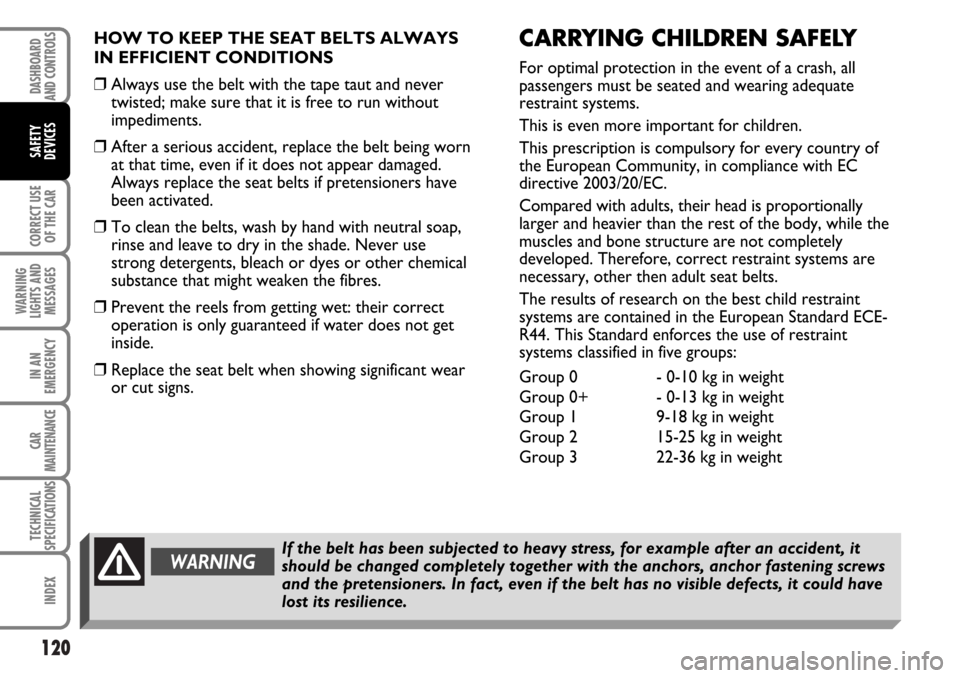
120
CORRECT USE
OF THE CAR
WARNING
LIGHTS AND
MESSAGES
IN AN
EMERGENCY
CAR
MAINTENANCE
TECHNICAL
SPECIFICATIONS
INDEX
DASHBOARD
AND CONTROLS
SAFETY
DEVICES
HOW TO KEEP THE SEAT BELTS ALWAYS
IN EFFICIENT CONDITIONS
❒Always use the belt with the tape taut and never
twisted; make sure that it is free to run without
impediments.
❒After a serious accident, replace the belt being worn
at that time, even if it does not appear damaged.
Always replace the seat belts if pretensioners have
been activated.
❒To clean the belts, wash by hand with neutral soap,
rinse and leave to dry in the shade. Never use
strong detergents, bleach or dyes or other chemical
substance that might weaken the fibres.
❒Prevent the reels from getting wet: their correct
operation is only guaranteed if water does not get
inside.
❒Replace the seat belt when showing significant wear
or cut signs.CARRYING CHILDREN SAFELY
For optimal protection in the event of a crash, all
passengers must be seated and wearing adequate
restraint systems.
This is even more important for children.
This prescription is compulsory for every country of
the European Community, in compliance with EC
directive 2003/20/EC.
Compared with adults, their head is proportionally
larger and heavier than the rest of the body, while the
muscles and bone structure are not completely
developed. Therefore, correct restraint systems are
necessary, other then adult seat belts.
The results of research on the best child restraint
systems are contained in the European Standard ECE-
R44. This Standard enforces the use of restraint
systems classified in five groups:
Group 0 - 0-10 kg in weight
Group 0+ - 0-13 kg in weight
Group 1 9-18 kg in weight
Group 2 15-25 kg in weight
Group 3 22-36 kg in weight
WARNINGIf the belt has been subjected to heavy stress, for example after an accident, it
should be changed completely together with the anchors, anchor fastening screws
and the pretensioners. In fact, even if the belt has no visible defects, it could have
lost its resilience.
Page 122 of 266
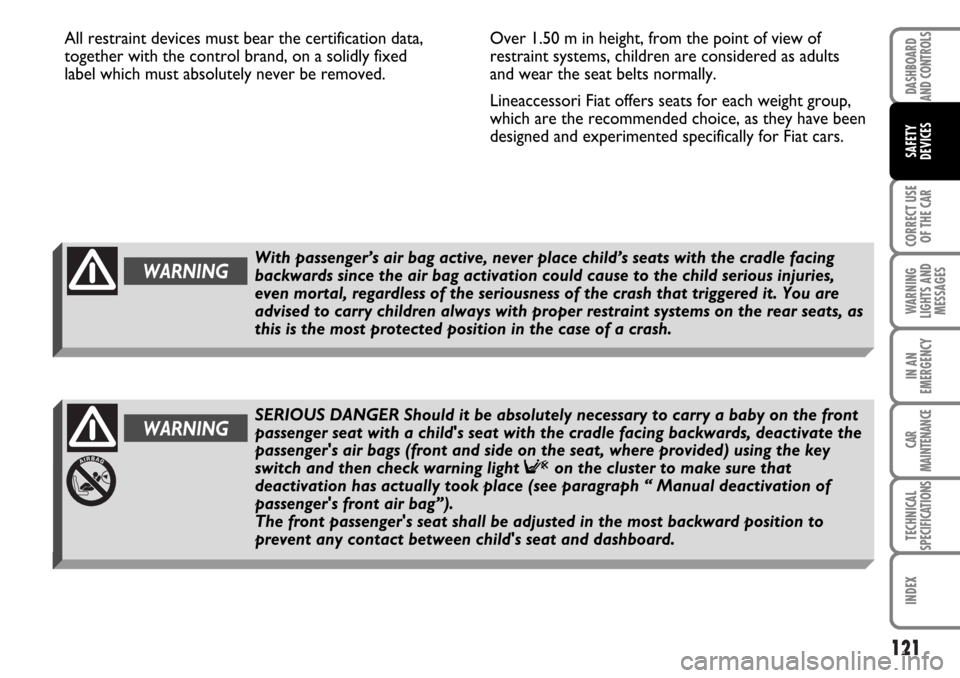
121
CORRECT USE
OF THE CAR
WARNING
LIGHTS AND
MESSAGES
IN AN
EMERGENCY
CAR
MAINTENANCE
TECHNICAL
SPECIFICATIONS
INDEX
DASHBOARD
AND CONTROLS
SAFETY
DEVICES
All restraint devices must bear the certification data,
together with the control brand, on a solidly fixed
label which must absolutely never be removed.Over 1.50 m in height, from the point of view of
restraint systems, children are considered as adults
and wear the seat belts normally.
Lineaccessori Fiat offers seats for each weight group,
which are the recommended choice, as they have been
designed and experimented specifically for Fiat cars.
WARNINGWith passenger’s air bag active, never place child’s seats with the cradle facing
backwards since the air bag activation could cause to the child serious injuries,
even mortal, regardless of the seriousness of the crash that triggered it. You are
advised to carry children always with proper restraint systems on the rear seats, as
this is the most protected position in the case of a crash.
WARNINGSERIOUS DANGER Should it be absolutely necessary to carry a baby on the front
passenger seat with a child's seat with the cradle facing backwards, deactivate the
passenger's air bags (front and side on the seat, where provided) using the key
switch and then check warning light
Fon the cluster to make sure that
deactivation has actually took place (see paragraph “ Manual deactivation of
passenger's front air bag”).
The front passenger's seat shall be adjusted in the most backward position to
prevent any contact between child's seat and dashboard.
Page 123 of 266
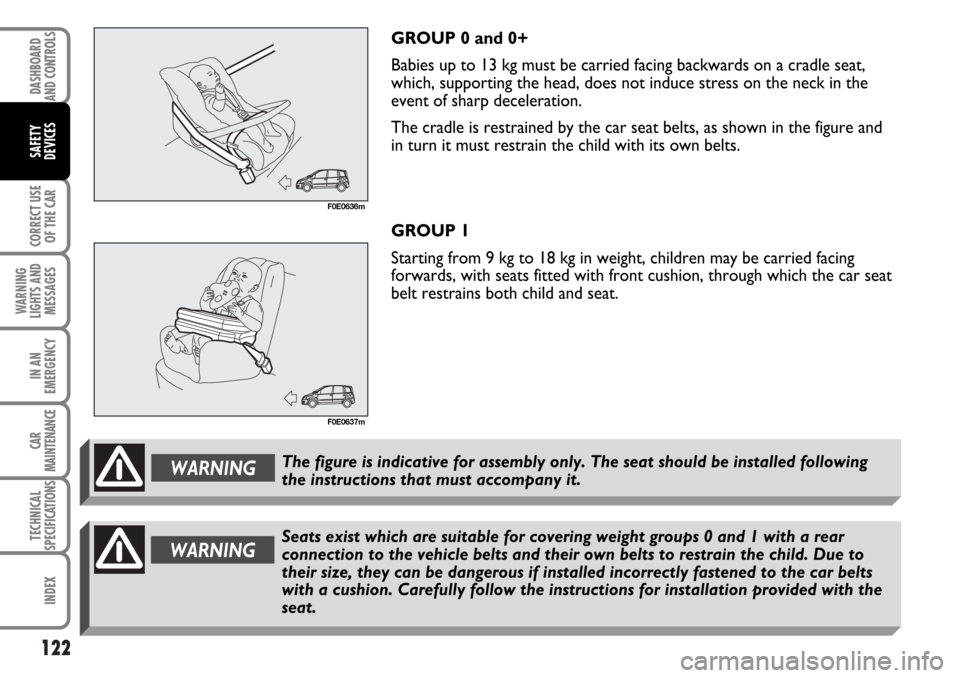
122
CORRECT USE
OF THE CAR
WARNING
LIGHTS AND
MESSAGES
IN AN
EMERGENCY
CAR
MAINTENANCE
TECHNICAL
SPECIFICATIONS
INDEX
DASHBOARD
AND CONTROLS
SAFETY
DEVICES
GROUP 0 and 0+
Babies up to 13 kg must be carried facing backwards on a cradle seat,
which, supporting the head, does not induce stress on the neck in the
event of sharp deceleration.
The cradle is restrained by the car seat belts, as shown in the figure and
in turn it must restrain the child with its own belts.
GROUP 1
Starting from 9 kg to 18 kg in weight, children may be carried facing
forwards, with seats fitted with front cushion, through which the car seat
belt restrains both child and seat.
F0E0636m
F0E0637m
WARNINGThe figure is indicative for assembly only. The seat should be installed following
the instructions that must accompany it.
WARNINGSeats exist which are suitable for covering weight groups 0 and 1 with a rear
connection to the vehicle belts and their own belts to restrain the child. Due to
their size, they can be dangerous if installed incorrectly fastened to the car belts
with a cushion. Carefully follow the instructions for installation provided with the
seat.
Page 124 of 266
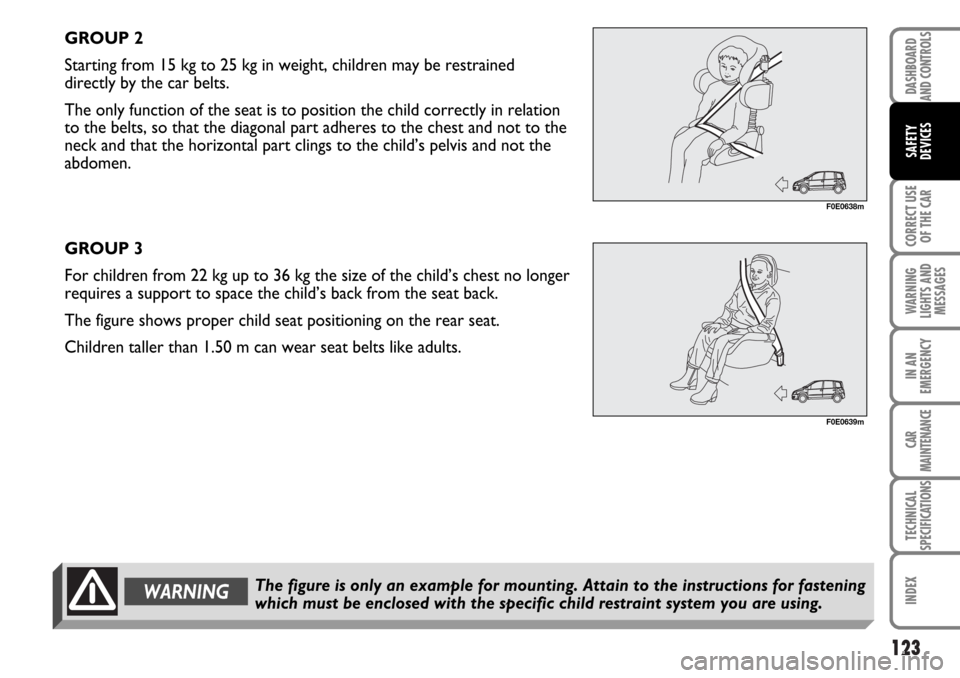
123
CORRECT USE
OF THE CAR
WARNING
LIGHTS AND
MESSAGES
IN AN
EMERGENCY
CAR
MAINTENANCE
TECHNICAL
SPECIFICATIONS
INDEX
DASHBOARD
AND CONTROLS
SAFETY
DEVICES
GROUP 2
Starting from 15 kg to 25 kg in weight, children may be restrained
directly by the car belts.
The only function of the seat is to position the child correctly in relation
to the belts, so that the diagonal part adheres to the chest and not to the
neck and that the horizontal part clings to the child’s pelvis and not the
abdomen.
GROUP 3
For children from 22 kg up to 36 kg the size of the child’s chest no longer
requires a support to space the child’s back from the seat back.
The figure shows proper child seat positioning on the rear seat.
Children taller than 1.50 m can wear seat belts like adults.
WARNINGThe figure is only an example for mounting. Attain to the instructions for fastening
which must be enclosed with the specific child restraint system you are using.
F0E0638m
F0E0639m
Page 126 of 266
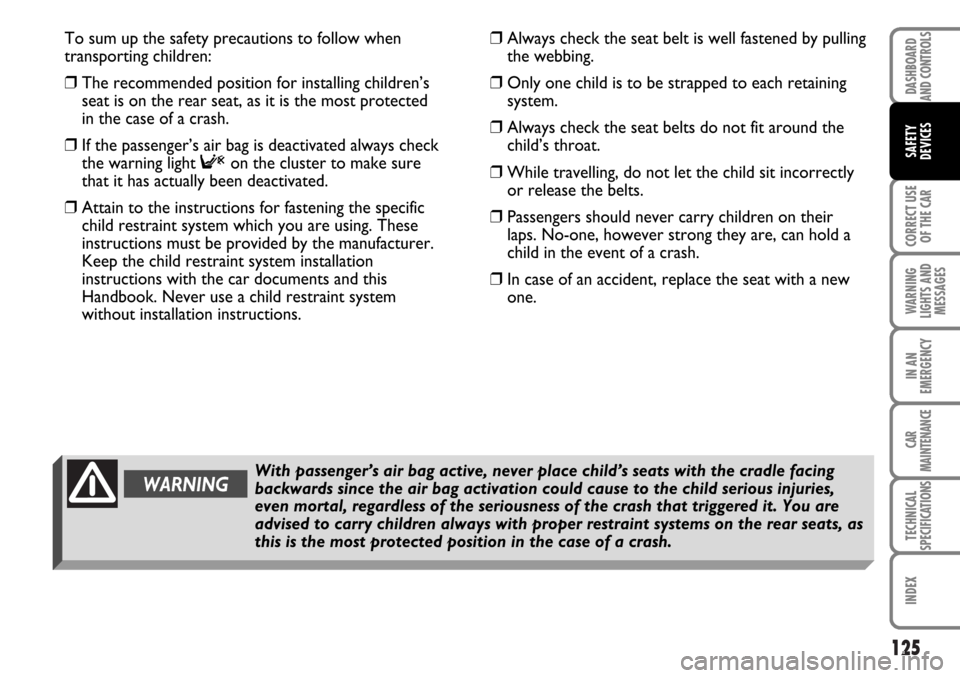
125
CORRECT USE
OF THE CAR
WARNING
LIGHTS AND
MESSAGES
IN AN
EMERGENCY
CAR
MAINTENANCE
TECHNICAL
SPECIFICATIONS
INDEX
DASHBOARD
AND CONTROLS
SAFETY
DEVICES
To sum up the safety precautions to follow when
transporting children:
❒The recommended position for installing children’s
seat is on the rear seat, as it is the most protected
in the case of a crash.
❒If the passenger’s air bag is deactivated always check
the warning light
Fon the cluster to make sure
that it has actually been deactivated.
❒Attain to the instructions for fastening the specific
child restraint system which you are using. These
instructions must be provided by the manufacturer.
Keep the child restraint system installation
instructions with the car documents and this
Handbook. Never use a child restraint system
without installation instructions.❒Always check the seat belt is well fastened by pulling
the webbing.
❒Only one child is to be strapped to each retaining
system.
❒Always check the seat belts do not fit around the
child’s throat.
❒While travelling, do not let the child sit incorrectly
or release the belts.
❒Passengers should never carry children on their
laps. No-one, however strong they are, can hold a
child in the event of a crash.
❒In case of an accident, replace the seat with a new
one.
WARNINGWith passenger’s air bag active, never place child’s seats with the cradle facing
backwards since the air bag activation could cause to the child serious injuries,
even mortal, regardless of the seriousness of the crash that triggered it. You are
advised to carry children always with proper restraint systems on the rear seats, as
this is the most protected position in the case of a crash.
Page 128 of 266
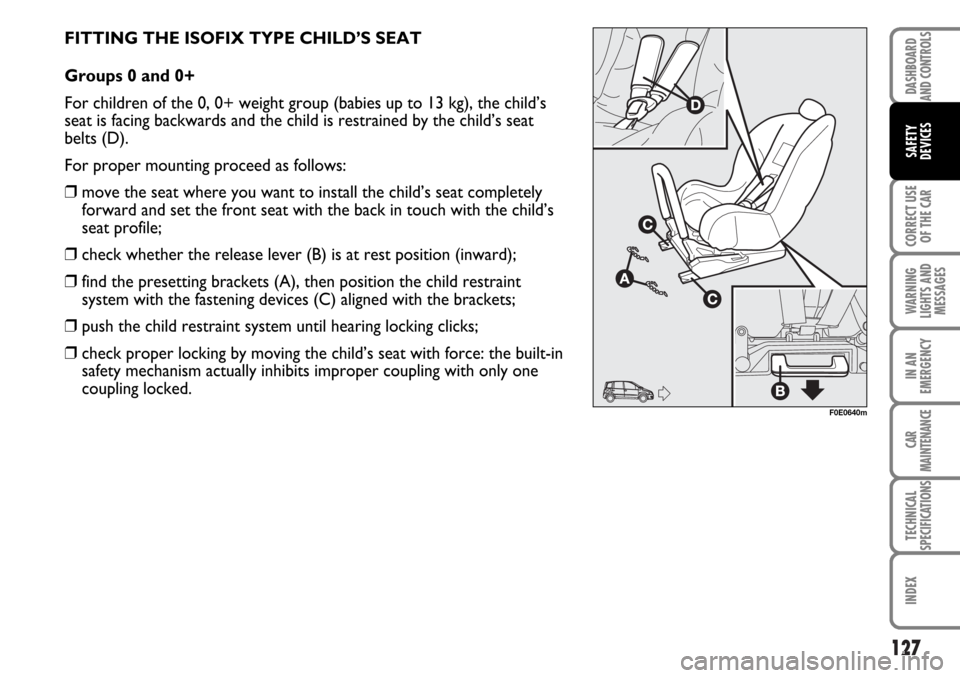
127
CORRECT USE
OF THE CAR
WARNING
LIGHTS AND
MESSAGES
IN AN
EMERGENCY
CAR
MAINTENANCE
TECHNICAL
SPECIFICATIONS
INDEX
DASHBOARD
AND CONTROLS
SAFETY
DEVICES
FITTING THE ISOFIX TYPE CHILD’S SEAT
Groups 0 and 0+
For children of the 0, 0+ weight group (babies up to 13 kg), the child’s
seat is facing backwards and the child is restrained by the child’s seat
belts (D).
For proper mounting proceed as follows:
❒move the seat where you want to install the child’s seat completely
forward and set the front seat with the back in touch with the child’s
seat profile;
❒check whether the release lever (B) is at rest position (inward);
❒find the presetting brackets (A), then position the child restraint
system with the fastening devices (C) aligned with the brackets;
❒push the child restraint system until hearing locking clicks;
❒check proper locking by moving the child’s seat with force: the built-in
safety mechanism actually inhibits improper coupling with only one
coupling locked.
F0E0640m
Page 129 of 266

128
CORRECT USE
OF THE CAR
WARNING
LIGHTS AND
MESSAGES
IN AN
EMERGENCY
CAR
MAINTENANCE
TECHNICAL
SPECIFICATIONS
INDEX
DASHBOARD
AND CONTROLS
SAFETY
DEVICES
Group 1
As the child grows, passing to weight group 1 (9-18 kg), refit the child’s
seat facing forwards following the installation instructions.
For proper mounting proceed as follows:
❒move the seat where you want to install the child’s seat completely
backwards;
❒check whether the release lever (B) is at rest position (inward);
❒find the presetting brackets (A), then position the child restraint
system with the fastening devices (C) aligned with the brackets;
❒push the child restraint system until hearing locking clicks;
❒check proper locking by moving the child’s seat with force: the built-in
safety mechanism actually inhibits improper coupling with only one
coupling locked.
With this configuration, the child is secured also by the car seat belts and
by the upper belts. To apply car seat belts to child’s seat refer to the
child’s seat handbook.
Adjust the front seat position moving it to half forward position.
F0E0641m
Page 130 of 266
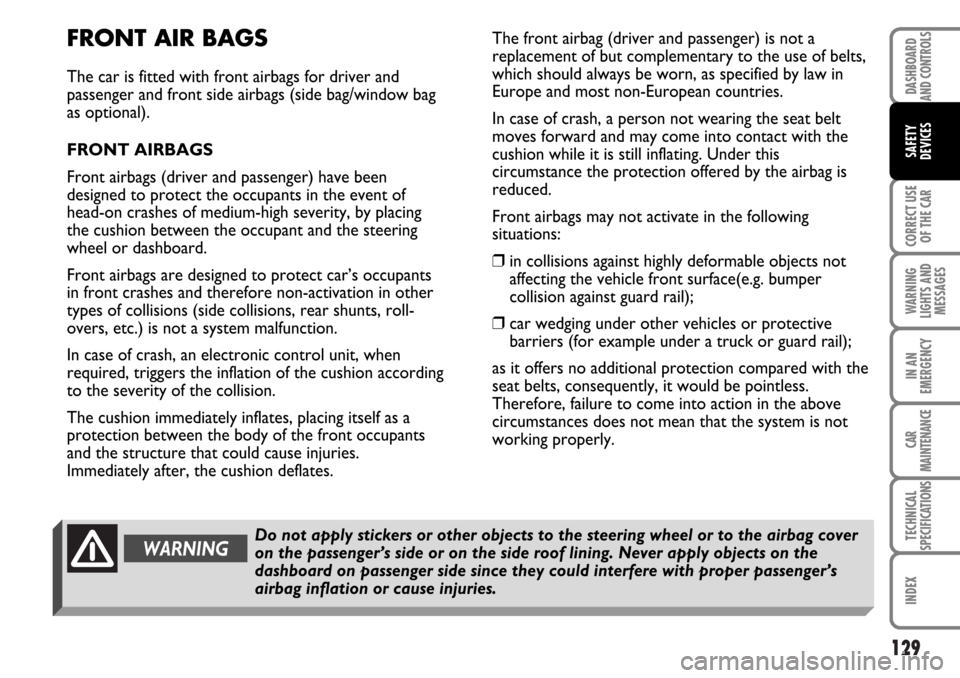
129
CORRECT USE
OF THE CAR
WARNING
LIGHTS AND
MESSAGES
IN AN
EMERGENCY
CAR
MAINTENANCE
TECHNICAL
SPECIFICATIONS
INDEX
DASHBOARD
AND CONTROLS
SAFETY
DEVICES
FRONT AIR BAGS
The car is fitted with front airbags for driver and
passenger and front side airbags (side bag/window bag
as optional).
FRONT AIRBAGS
Front airbags (driver and passenger) have been
designed to protect the occupants in the event of
head-on crashes of medium-high severity, by placing
the cushion between the occupant and the steering
wheel or dashboard.
Front airbags are designed to protect car’s occupants
in front crashes and therefore non-activation in other
types of collisions (side collisions, rear shunts, roll-
overs, etc.) is not a system malfunction.
In case of crash, an electronic control unit, when
required, triggers the inflation of the cushion according
to the severity of the collision.
The cushion immediately inflates, placing itself as a
protection between the body of the front occupants
and the structure that could cause injuries.
Immediately after, the cushion deflates.The front airbag (driver and passenger) is not a
replacement of but complementary to the use of belts,
which should always be worn, as specified by law in
Europe and most non-European countries.
In case of crash, a person not wearing the seat belt
moves forward and may come into contact with the
cushion while it is still inflating. Under this
circumstance the protection offered by the airbag is
reduced.
Front airbags may not activate in the following
situations:
❒in collisions against highly deformable objects not
affecting the vehicle front surface(e.g. bumper
collision against guard rail);
❒car wedging under other vehicles or protective
barriers (for example under a truck or guard rail);
as it offers no additional protection compared with the
seat belts, consequently, it would be pointless.
Therefore, failure to come into action in the above
circumstances does not mean that the system is not
working properly.
WARNINGDo not apply stickers or other objects to the steering wheel or to the airbag cover
on the passenger’s side or on the side roof lining. Never apply objects on the
dashboard on passenger side since they could interfere with proper passenger’s
airbag inflation or cause injuries.
Page 131 of 266
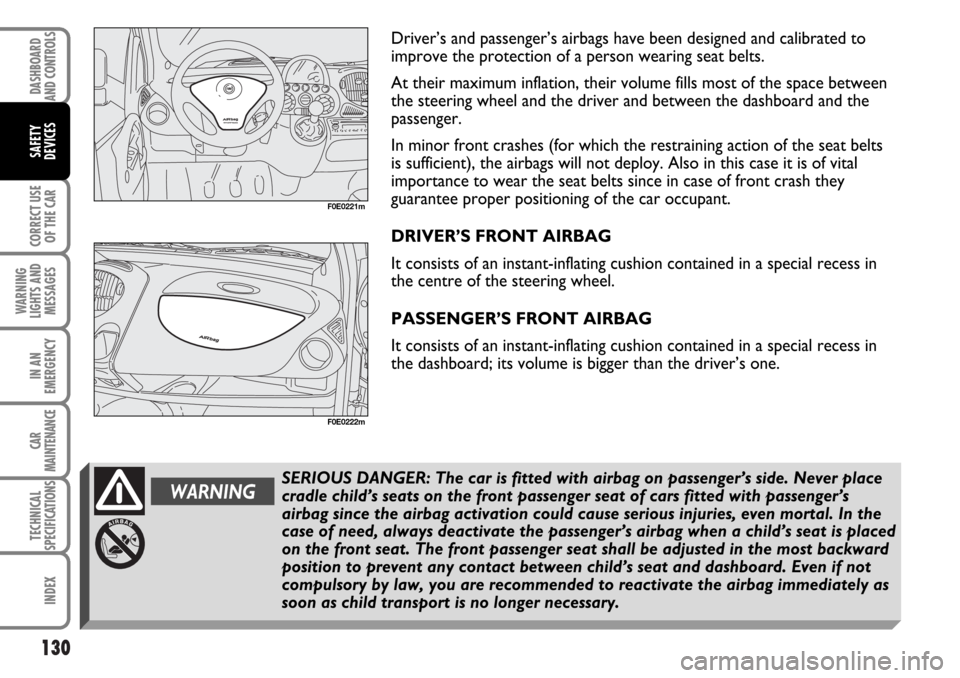
130
CORRECT USE
OF THE CAR
WARNING
LIGHTS AND
MESSAGES
IN AN
EMERGENCY
CAR
MAINTENANCE
TECHNICAL
SPECIFICATIONS
INDEX
DASHBOARD
AND CONTROLS
SAFETY
DEVICES
Driver’s and passenger’s airbags have been designed and calibrated to
improve the protection of a person wearing seat belts.
At their maximum inflation, their volume fills most of the space between
the steering wheel and the driver and between the dashboard and the
passenger.
In minor front crashes (for which the restraining action of the seat belts
is sufficient), the airbags will not deploy. Also in this case it is of vital
importance to wear the seat belts since in case of front crash they
guarantee proper positioning of the car occupant.
DRIVER’S FRONT AIRBAG
It consists of an instant-inflating cushion contained in a special recess in
the centre of the steering wheel.
PASSENGER’S FRONT AIRBAG
It consists of an instant-inflating cushion contained in a special recess in
the dashboard; its volume is bigger than the driver’s one.
F0E0221m
F0E0222m
WARNINGSERIOUS DANGER: The car is fitted with airbag on passenger’s side. Never place
cradle child’s seats on the front passenger seat of cars fitted with passenger’s
airbag since the airbag activation could cause serious injuries, even mortal. In the
case of need, always deactivate the passenger’s airbag when a child’s seat is placed
on the front seat. The front passenger seat shall be adjusted in the most backward
position to prevent any contact between child’s seat and dashboard. Even if not
compulsory by law, you are recommended to reactivate the airbag immediately as
soon as child transport is no longer necessary.
Page 136 of 266
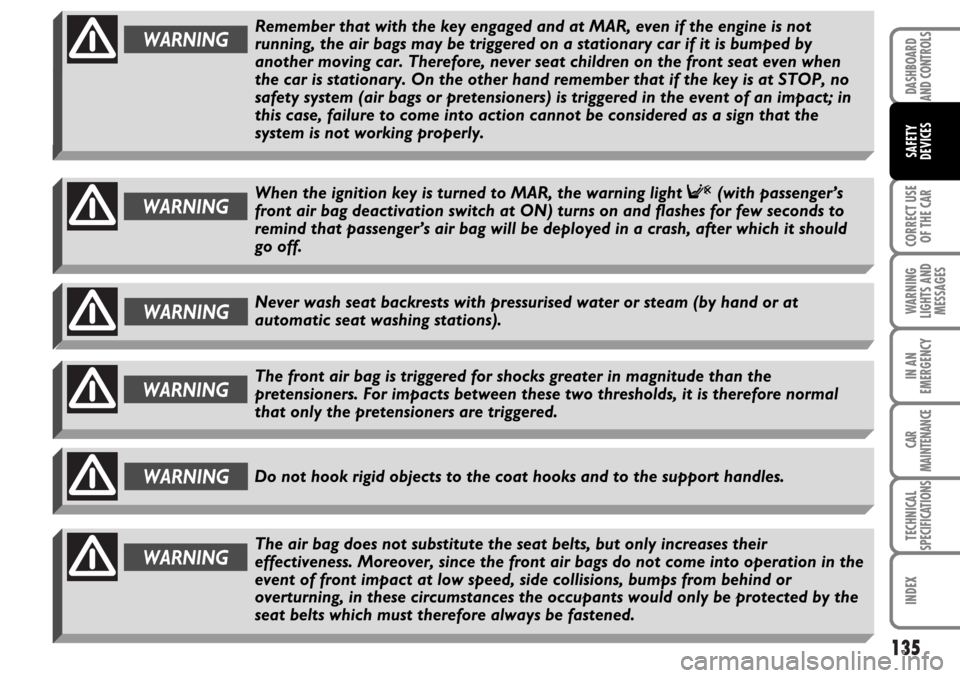
135
CORRECT USE
OF THE CAR
WARNING
LIGHTS AND
MESSAGES
IN AN
EMERGENCY
CAR
MAINTENANCE
TECHNICAL
SPECIFICATIONS
INDEX
DASHBOARD
AND CONTROLS
SAFETY
DEVICES
Do not hook rigid objects to the coat hooks and to the support handles.WARNING
The front air bag is triggered for shocks greater in magnitude than the
pretensioners. For impacts between these two thresholds, it is therefore normal
that only the pretensioners are triggered.WARNING
WARNINGWhen the ignition key is turned to MAR, the warning light F(with passenger’s
front air bag deactivation switch at ON) turns on and flashes for few seconds to
remind that passenger’s air bag will be deployed in a crash, after which it should
go off.
WARNINGNever wash seat backrests with pressurised water or steam (by hand or at
automatic seat washing stations).
WARNINGRemember that with the key engaged and at MAR, even if the engine is not
running, the air bags may be triggered on a stationary car if it is bumped by
another moving car. Therefore, never seat children on the front seat even when
the car is stationary. On the other hand remember that if the key is at STOP, no
safety system (air bags or pretensioners) is triggered in the event of an impact; in
this case, failure to come into action cannot be considered as a sign that the
system is not working properly.
WARNINGThe air bag does not substitute the seat belts, but only increases their
effectiveness. Moreover, since the front air bags do not come into operation in the
event of front impact at low speed, side collisions, bumps from behind or
overturning, in these circumstances the occupants would only be protected by the
seat belts which must therefore always be fastened.